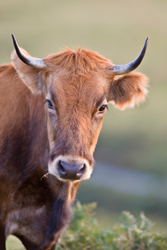Construction of a BAC map of the bovine genome
The BOVGEN project created advanced genomic tools that allowed researchers to identify the genes responsible for important traits in cattle. A set of 20,000 non-redundant complementary DNA (cDNA) fragments were sequenced and used to construct a high-density gene map for the bovine genome. This helped to identify the position of candidate genes for mapped traits. The information regarding genetic sequence and radiation hybrid maps was used to construct a physical BAC map of the entire cattle genome. This in turn was used for targeted DNA sequencing. Bacterial chromosomes were used as hosts for pieces of bovine chromosome. These hosts generated many identical copies of a piece, or clone, of bovine DNA. The BAC map was the collection of overlapping clones, which represented the entire genome. BAC contiguous overlapping clones (or contigs) that had end sequence or genetic markers embedded helped to identify the positioning and orientation of sequences. The map not only helped to identify useful traits, it will also greatly help future efforts to sequence the entire genome for cattle. The BAC map and sequence information can be used to more accurately select genetically superior cattle for specific needs. These may include leaner beef, higher milk yields, reduced feed requirements, and improved health. The data from the BOVGEN project was made available to the International Bovine Genome Sequencing Project to assist in the assembly of the sequences.







